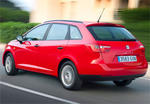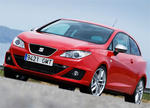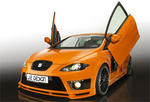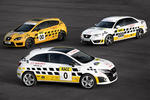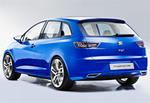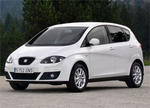
The new Seat IBE concept has been unveiled today at the Geneva auto show and represents a new compact sports coupe. The two-door Seat IBE concept measures 3.78 meters in length, 25 centimeters shorter than an Ibiza, 1.80 meters in width and 122 centimeters in height. The power of the Seat IBE concept comes from an electric motor juiced by a lithium-ion battery that develops 75 kW (102 PS) and 200 Nm of torque. The Seat IBE concept is aimed at city traffic so don't expect mind bending acceleration times. The Seat IBE concept needs 3.4 seconds to reach 50 km/h and 9.4 seconds to reach 100 km/h. The top speed is limited to 160 km/h.
Some interesting design feature of the Seat IBE concept include the full-LED headlamps,
the low bonnet and long roof line.
Seat has not mention yet if the Seat IBE concept will spawn a production model.
Seat Press Release:
Seat is delivering a powerful statement with a compact sports coupe that carries stunning design


and great driving fun into the age of electric mobility. The Seat IBE concept car uses the zero-emissions drive of the future in a sporty and dynamic concept for urban mobility, while the clean, athletic styling of the Seat IBE concept offers an exciting perspective on the ongoing development of the next generation of Seat design. Powerful proportions and a precise, clear design language define the continued evolution of the Spanish brand’s design DNA.
Short, low and wide, an extremely low front end and broad shoulders – at first glance, the Seat IBE displays the proportions of a classic sports
car. Yet, it interprets this style genre in an innovative and unique manner – in a compact vehicle optimised for youthful living in urban areas.
“With the Seat IBE, we are demonstrating that, for Seat, electric mobility will always be combined with excellent design and outstanding driving fun,” says James Muir, President of Seat, S.A. “The Seat IBE is in the best Seat tradition of always offering the boldest and most youthful cars in its class. On top of that, our first electric concept car represents the continuation of our strategy
for the future; after the huge success of the highly efficient ECOMOTIVE models, we are now working intensively on electric mobility; and that includes plug-in hybrid drive, as well as an all-electric vehicle.”
The design
The Seat IBE concept car delivers an enticing perspective on the ongoing development of Seat design. The pure forms, the precise lines and the exact surfaces depict a consistent and unique design language that clearly sustains the Seat identity in all its modernity. “The Seat IBE is like a concentrated gene pool for our next generation of vehicles. It will have a clear impact on all our models.” says Seat Chief
Designer Luc Donckerwolke. “And it also represents a promise for the future of the automobile – even with electric drive, design will still be exciting and driving will still be fun; at least, in a Seat.”
The Seat IBE is 3.78 metres long – making it more than 25 centimetres shorter than an Ibiza - but its unusual breadth of 1.80 metres and overall height of only 122 centimetres lend it classic sports car proportions. Another classically sporty feature of the two-door layout is its extremely low bonnet and its long roof line. The short front overhang and muscular rear end with almost no overhang work together with the 19-inch wheels to underscore the car’s powerful and compact look.
The front end is characterised by full-LED headlamps that are as sophisticated in their design as they are distinctive. They bear the characteristic V typical of Seat’s so-called “arrow design”. The entire front end takes a powerful V form that then carries on through the bonnet. The two air intakes in the lower bumper section are ample for the relatively low cooling requirements of the electric drive. The Seat logo is located on a trapezoidal functional surface. The alternative drive enables an extremely high degree of consistency in the design – because the compact electric motor and its power electronics require less packaging space, it was possible to stretch the V-shaped bonnet a lot flatter across the front end than would have been possible with an internal combustion engine.
The side profile of the Seat IBE emphasises its powerful stature – its broad shoulders, its sculpted flanks with a distinctive cut-in behind the front wheel, and the large wheels featuring an aerodynamically optimised five-spoke design all serve to underscore the dynamic look. The tires, on the other hand, with their 175 format, are far from extreme – with their low rolling resistance, they contribute to the high efficiency of the electric concept car. The roofline stretches rearwards, with the side glass surfaces kept low.
The rear end picks up the characteristic form of the front and reinterprets it. The rear light clusters featuring LED light guide technology once again display the “arrow” thematic with a hint of a diffuser beneath the rear bumper area reflecting the visual of the front air intakes. The entire vehicle is completely free from ornamentation – good design needs no decor. Every single line has its function in structuring the volumes and surfaces of the car; every muscle emerging from the form emphasises the sporty design. The reduction of forms, their consistent application and the precision in every detail are fixed elements of the Seat design philosophy – and will be even more evident in future.
The concept
With its manageable dimensions, its agility and dynamics, the Seat IBE is the perfect fit for city streets. Tightly cut as a 2+2-Seater, it is conceived for youthful lifestyles. It has plenty of space for a couple, while also offering capacity for four. The long roofline ensures good interior headroom, while still retaining space for luggage or leisure equipment.
“Seat has set itself the challenge to develop new concepts for new mobility demands in large cities,” says Frank Bekemeier, who is Executive Vice President for Research and Development at Seat. “The Seat IBE is a zero-emissions vehicle, which is becoming increasingly important in many areas, and is optimised for future information systems. With its compact dimensions, its great manoeuvrability and high degree of usability, it is the perfect fit for the multi-faceted demands of a young target group.”
The Seat IBE is an all-electric vehicle that generates zero local emissions. The drive motor is located together with the power electronics beneath the extremely flat bonnet, with the lithium-ion battery positioned in the car’s very short rear. With a maximum output of 75 kW (102 hp) and 200 Nm of torque, the power unit delivers exactly the kind of dynamic driving fun suggested by the exterior styling. The city dash from 0 to 50 km/h takes only 3.4 seconds; within 6.3 seconds, the Seat IBE has reached 80 km/h, and after only 9.4 seconds it arrives at 100 km/h. This impressive performance is a function not only of the powerful off-the-line characteristics of the electric motor, but also the low weight of the Seat IBE, which tips the scales at only 1,000 kilograms.
The continuous power rating it limited to 50 kW (68 hp), with the top speed pegged at 160 km/h – which is more than enough to cut an impressive figure even on urban motorways. Battery capacity is 18 kWh, which is plenty to cover all the daily mobility requirements of city life. It goes without saying that the Seat IBE is equipped with the latest safety and communication systems and, in particular, is prepared for car-to-x communication. Within the information network of the future, the Seat IBE exchanges data concerning status or safety alerts directly with other vehicles or the traffic infrastructure.
The expertise
Seat is a vehicle manufacturer with a particularly high degree of expertise in environmentally friendly technologies. Recent years have seen fuel consumption systematically reduced across the individual model ranges, with Seat ECOMOTIVE emerging to enjoying enormous success on the market as a brand for exceptionally high-efficiency vehicles. The pinnacle is the Ibiza ECOMOTIVE, which, despite its powerful 59 kW (80 hp) output consumes only 3.7 litres of fuel per 100 kilometres and emits only 98 grams of CO2 per kilometre. Seat continues to expand the ECOMOTIVE range, with the Leon, Altea, Altea XL and Alhambra also set to receive exceptionally low-consumption TDI variants.
The next step in the Seat strategy is the Leon Twin Drive ECOMOTIVE. Its drive is derived from a combination of an internal combustion engine and an electric motor. Yet it is far more than a conventional hybrid; it is a plug-in vehicle. Its lithium-ion battery can be charged at a regular electrical socket and has a range fully-charged of around 50 kilometres. For longer trips, the internal combustion engine takes over. The first series production version of the Leon Twin Drive ECOMOTIVE is planned for 2014.
The development target is the all-electric vehicle, with the Seat IBE concept car serving as a taster. At the same time, the Seat IBE marks the start of a targeted project for the promotion and development of electric mobility in Spain. The Cenit VERDE initiative brings together the capabilities of 16 leading technology companies and 16 leading universities and research establishments.
With its expertise in research, development and production, Seat has taken over the industrial leadership of this project. Support by the Spanish Ministry for Science and Innovation (CDTI), the company will explore, develop and establish the fundamental requirements for electric mobility. The objective is to explore technologies for the production of electric vehicles in Spain and for the establishment of the associated infrastructure.
“This project is very important for Spain, for its technological development, its future perspectives and its industrial network,” says Frank Bekemeier, Seat Executive Vice President for Research and Development. “The initiative is one of the most ambitious challenges faced by this country. With the Seat IBE concept car, we are providing this process with very clear impetus.”
Seat is breaking the mould, once again, at the 2010 Geneva Motor Show with the unveiling of its remarkable new concept car: the Seat IBE.
The world debut of this compact sports coupé brings stunning design and great driving fun into the age of electric mobility.
The Seat IBE concept car uses the zero-emissions drive of the future in a sporty and dynamic concept for urban mobility. Meanwhile the clean, athletic styling of the concept car gives a subtle clue to the ongoing development of the next generation of Seat design.
Powerful proportions and a precise, clear design language define the continued evolution of the Spanish brand’s design DNA.
Short, low and wide with an extremely low front end and broad shoulders – at first glance, the Seat IBE seems to have the proportions of a classic sports car. Yet, it interprets this style genre in an innovative way to create a compact vehicle optimised for youthful living in urban areas.
James Muir, President of Seat S.A. said: ‘With the Seat IBE we are demonstrating that, for Seat, electric mobility will always be combined with excellent design and outstanding driving fun.
‘The Seat IBE is in the best Seat tradition of always offering the boldest and most youthful cars in its class. On top of that, our first electric concept car represents the continuation of our strategy for the future.
‘Along with the huge success of the highly efficient Ecomotive models, we are now working intensively on electric mobility; and that includes plug-in hybrid drive, as well as an all-electric vehicle.’
The Seat IBE is 3.78 metres long – making it more than 25 centimetres shorter than an Ibiza – but its unusual breadth of 1.80 metres and overall height of just 122 centimetres lend it classic sports car proportions.
Classically sporty features of the two-door layout include its extremely low bonnet and long roof line. The short front overhang and muscular rear end work together with the arch-filling 19-inch wheels to underscore the car’s powerful, compact look.
Visual highlights include the full LED headlamps, trademark Arrow Design nose, elongated and flattened V-shaped bonnet (made possible thanks to use of a full electric motor), broad ‘shoulders’ and sculpted flanks. At the back, the rear light clusters again feature LED light guide technology and once again display the ‘arrow’ thematic.
Tightly cut as a 2+2, the Seat IBE is conceived for youthful lifestyles and while it has plenty of space for a couple, there is also the possibility of carrying up to four.
The Seat IBE’s motor is found beneath the extremely flat bonnet, with the lithium-ion battery positioned in the car’s very short rear. With a maximum output of 75 kW (102 PS) and 200 Nm of torque, the power unit delivers exactly the kind of dynamic driving fun you might expect of a car that looks so sporty. The typical ‘city dash’ from 0 to 50 km/h takes only 3.4 seconds; within 6.3 seconds the Seat IBE has reached 80 km/h and, after only 9.4 seconds, it arrives at 100 km/h.
The 1,000 kg car’s continuous power rating is limited to 50 kW (68 PS), with the top speed pegged at 160 km/h – more than enough to cut an impressive dash even on urban motorways.
Batterycapacity is 18 kWh, which is plenty to cover all the daily mobility requirements of city life.
It goes without saying, of course, that the Seat IBE is equipped with the latest safety and communication systems and, in particular, is prepared for car-to-x communication. Anticipating the information network of the future, the car is even capable of exchanging data about its status or safety alerts directly with other vehicles or the traffic infrastructure.





